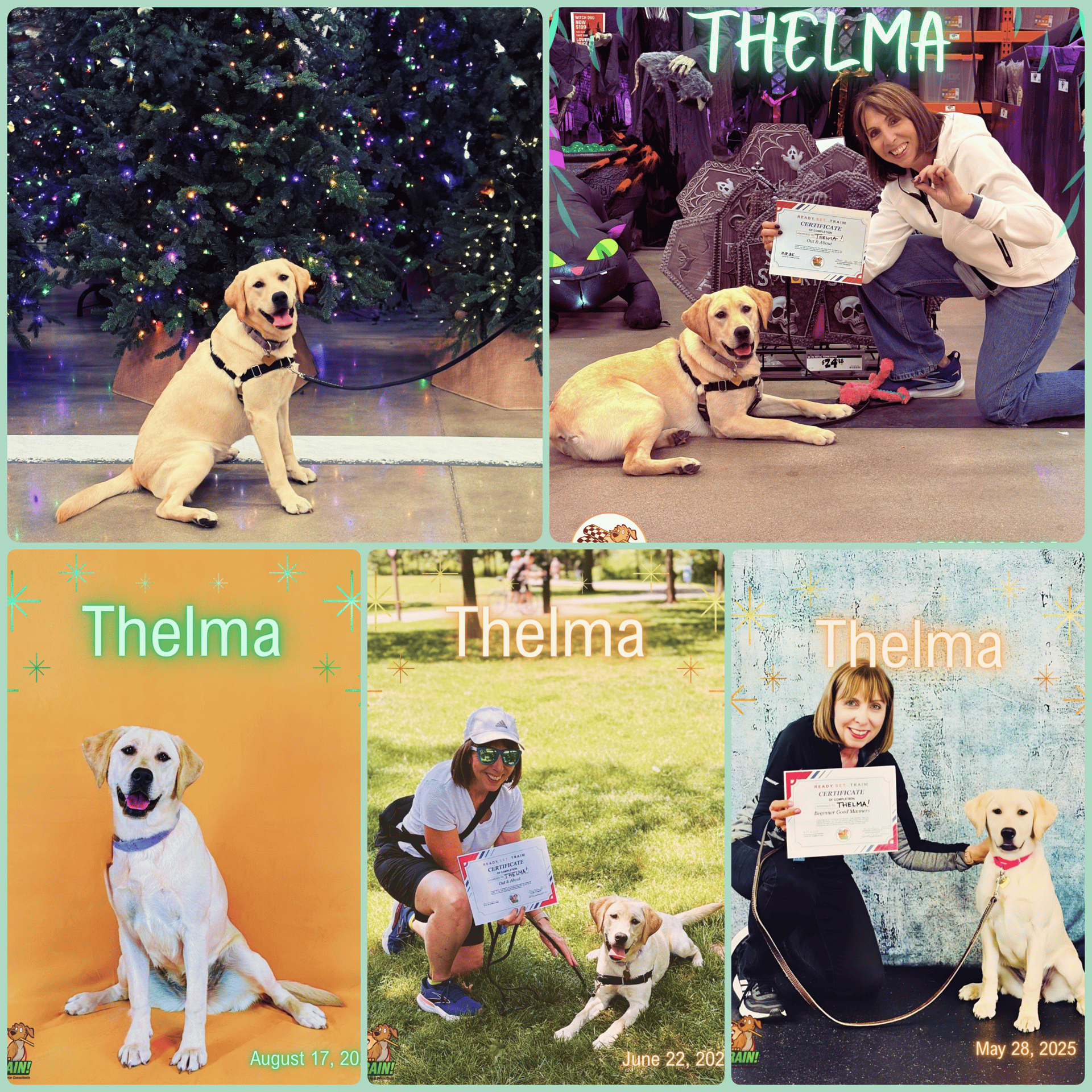- ReadySetTrainDogs' Newsletter
- Posts
- The Monthly Wag: November 2025
The Monthly Wag: November 2025
Ready Set...Train! Monthly Newsletter
Hello Fellow Dog Lovers!
Thank you for subscribing to our monthly newsletter! We’re thrilled to have you be a part of our ever growing community of dog lovers and training enthusiasts. Each month, you can look forward to receiving valuable training tips, behavior insights, and updates on our upcoming events and classes. We're excited to share this journey with you and your furry friend(s)!🐾
Make sure you are not missing our emails! Mark our newsletter as important in your inbox! Please help us grow this newsletter by sharing it with your family and friends!
Table of Contents
Featured Upcoming Class:

Rally is a great way to build focus, attention, and team work with your dog!
Each month, we feature one of our upcoming classes to give you a deeper look into what the class entails. This month, we’re excited to highlight our AKC Rally Novice Class
What is AKC Rally?
Rally is one of the AKC’s newest and most popular dog sports, combining elements of obedience and agility. In this sport, a dog and handler work together as a team to complete a course while competing against others. Depending on the level, a rally course consists of 10–20 signs/stations, each requiring your dog to perform a specific behavior.
These behaviors range from simple commands like “sit” and “down” to more advanced tasks such as circling around your body in a specific direction, being sent to a jump, or weaving through cones while ignoring distractions
Each team starts with 100 points, and judges deduct points for mistakes like incorrectly performing behaviors, crooked sits/downs, or slow responses. The team with the highest score at the end wins, and any dog scoring above 70 qualifies toward earning their class title.
Why Try Rally?
Rally is a fun and rewarding way to strengthen your bond with your dog while building focus, teamwork, and engagement. This sport challenges dogs both mentally and physically, making it a great way to improve obedience and confidence.
Who Can Participate?
Any dog can join Rally! Your dog just needs to know basic commands like sit, down, and stay, and be able to walk well on a leash. In our Rally classes, we’ll teach you all the necessary skills for each level, starting with Novice. Whether you’re preparing for competition or just looking for a fun learning experience, we’ve got you covered! Rally is also a great stepping stone into other dog sports like agility, scent work, or competitive obedience.
If you’ve been thinking about trying a dog sport, Rally is the perfect place to start!
➡️ Join our upcoming Rally Novice class starting January 9th by clicking the link: https://www.readysettraindogs.com/book-online?category=e60c2227-6d3e-4d77-9eae-08312aa6980c
Monthly Training Video: Why Dogs Wear Muzzles
Why Choose Ready Set…Train! for Group Training Classes?
Dogs of the Month: Thelma

Name: Thelma Louise
Age: 11 months (on 11/7/25)
Favorite Activity: Orbiting at 100 mph!
Favorite Food: Everything! (She is a lab!)
Favorite Trick: Tunnel under her dad Mike’s legs when he is sitting! It was easy when Thelma was a puppy but now nearly impossible as she has gotten so tall!
Best personality trait: Openness
Fun Fact: She goes for a swim in the pool anytime she wants!
Thelma has been training with us since she was a tiny pup, and she and her mom have taken many of our classes over the past year. We love her happy face in sessions—she tackles every activity with an enthusiasm that’s downright contagious!
As a young dog, Thelma is still practicing polite greetings (she’s convinced everyone is her best friend) and impulse control around distractions. We feel lucky to be part of Thelma’s learning and development and can’t wait to see her grow into higher-level training as she matures.

The Myth of the Three-Day Stress Cycle: How Stress Really 'Sticks' to Our Dogs
When we talk about stress "sticking around" in an animal’s system, we are referring to glucocorticoids—the stress hormone most commonly known as cortisol. To truly understand how stress affects our dogs, let's look at the science behind the stress response.
We define stress as a natural, physiological, and psychological response to perceived challenges or threats to an animal's normal state. Not every challenge is harmful! According to researcher Bruce McEwen, stress can be broken down into categories:
Good Stress (Eustress): A challenge that is not unpleasant, such as learning a new trick, playing, or exploring a safe area. The animal copes and grows.
Tolerable Stress: Unpleasant, but the animal is able to cope and recover.
Toxic Stress: The animal cannot cope with or escape the stressful situation.
When your dog's brain detects a stress/a threat, two primary systems activate instantly:
The Hypothalamic Pituitary Adrenal Axis(HPA Axis): A complicated sequence that ultimately releases the stress hormones, including cortisol.
The Sympathetic Nervous System: This system releases norepinephrine and epinephrine (adrenaline), plunging the animal into fight or flight.
These systems flood the dog's body, causing physiological changes like increased heart rate, rapid breathing, and a surge in blood sugar. This prepares them to face or flee the perceived challenge.
How Long Does Cortisol Stay in the System?
For a healthy, non-stressed dog? Not long.
In a healthy system, the body triggers a "shut-off valve" (a negative feedback loop) once cortisol levels peak. Studies show that a normal dog typically reaches this peak and begins cycling stress hormones out within 15–30 minutes.
*So, does stress stay in the system for three days? For healthy dogs, absolutely not.
The Exception: Chronic Stress & The Three-Hour Cycle
The simple answer above changes dramatically when a dog is under chronic stress. Chronic stress is a prolonged state of strain caused by ongoing, inescapable stressors in the dog’s life.
Dogs under chronic stress have a higher baseline level of cortisol.
More importantly, it takes them much longer to trigger the "shut-off valve." Studies show these dogs generally take around 3 hours to cycle stress hormones out of their system.
The Real Reason Stress Lasts: Sensitization
While the actual stress hormone (cortisol) is cleared within hours, the effects of stress can linger for days, weeks, or even indefinitely. This is due to a neurological concept called sensitization.
Sensitization refers to a process where repeated or highly traumatic exposure to a stimulus leads to an increased responsiveness to that stimulus over time. This increased sensitivity can last up to several weeks.
Even more troubling is Cross-Sensitization. Research (often using models like "inescapable shock" that leads to learned helplessness) shows that an animal isn't just sensitized to the original trigger. Instead, the entire system becomes hyper-vigilant:
Any other aversive or stressful stimulus will also trigger this heightened sensitivity and anxiety, even without repeated exposure to that new trigger.
If a dog is experiencing cross-sensitization, they will experience a heightened, anxious response to stress and aversive stimuli for up to 10 days, sometimes longer. This prolonged state of anxiety contributes to chronic stress, which, in turn, prolongs the cortisol cycle.
No, the cortisol doesn't stay in the system for three days, but the complicated combination of stress pathways and cross-sensitization can result in a dog who is stressed out for not just three days, but possibly weeks. Some animals may never be able to get out of the loop at all.
What Can We Do to Help?
The good news is we have the tools to help reduce toxic stress and lower their baseline anxiety:
Stop Aversives: Eliminate the use of training methods and tools that rely on repeated punishment or aversive stimuli.
Manage Exposure: When training, always create exposure scenarios at a manageable level for your dog. Never allow your dog to go "over threshold" (past the point where they can think and cope).
Prioritize Recovery: Recognize and respect your dog's need for time to de-stress. Now that you know how long stress truly affects the system, give them appropriate rest and enrichment.
Resources:
Garcia, Arantxa, Octavi Marti, Astrid Valles, Silvina Dal-Zotto, and Antonio Armario. “Recovery of the Hypothalamic-Pituitary-Adrenal Response to Stress: Effect of Stress Intensity, Stress Duration and Prevention Stress Exposure.” Neuroendocrinology 72, no. 2 (August 2000): 114–25.
Belda, X., Rotllant, D., Fuentes, S., Delgado, R., Nadal, R., & Armario, A. (2008). Exposure to severe stressors causes long‐lasting dysregulation of resting and stress‐induced activation of the hypothalamic‐pituitary‐adrenal axis. Annals of the New York Academy of Sciences, 1148(1), 165-173.
Upcoming Classes/Events
11/9: 1:00 pm- Out and About Class | First Class
11/14: 6:00 pm- Triggered Class | First Class
11/19: 7:15 pm- Beginner Good Manners | First Class
12/9: 11:30 am- Triggered Class | First Class
All of our upcoming class still have several spots available. Sign up today! https://www.readysettraindogs.com/group-training-classes


Reply